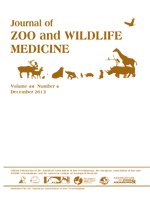This study evaluates the cardiorespiratory and physiologic effects of three different protocols of chemical restraint using isoflurane in captive brown brocket deer (Mazama gouazoubira). Six adult deer, two males and four females, aged 3–6 yr old and weighing 16.3 ± 1.5 kg (mean ± SD), were used. The deer were physically restrained and anesthetized using one of three protocols: protocol 1 (P1), anesthesia was induced directly with isoflurane using a facemask and maintained for 1 hr with isoflurane delivered by endotracheal tube; protocol 2 (P2), oral premedication with midazolam was followed 1 hr later by induction and maintenance of anesthesia with isoflurane, as in P1; and protocol 3 (P3), intravenous anesthesia using a combination of ketamine, xylazine, and atropine was followed by isoflurane anesthesia, as in P1. Cardiorespiratory variables were recorded during physical restraint (T0); 5 min after intubation (T5); and every 10 min during anesthesia (T15–T55). Venous and arterial blood gas analysis was conducted at T0 (venous blood only), T15, T35, and T55. Data were analyzed by the appropriate statistical tests. P values < 0.05 were considered significant. Under P1, three deer regurgitated during induction and one of them died because of aspiration pneumonia. The end-tidal isoflurane concentration differed significantly between P1, P2, and P3 (2.6 ± 0.2, 2.3 ± 0.5, and 0.9 ± 0.3%, respectively). Hypotension was observed during anesthesia (T15–T55). Respiratory acidosis occurred at all times and protocols, and pH was significantly lower in P1 compared to P2 and P3. Metabolic acidosis was also observed following physical restraint (T0–T35) in all protocols. The use of isoflurane via facemask for anesthesia induction is not a safe method in deer that are not premedicated. Isoflurane used alone or in combination with midazolam and ketamine–xylazine–atropine combination causes hypotension and dose-dependent respiratory acidosis.
How to translate text using browser tools
31 December 2013
PHYSIOLOGIC EFFECTS OF THREE DIFFERENT PROTOCOLS OF ISOFLURANE ANESTHESIA IN CAPTIVE BROWN BROCKET DEER (MAZAMA GOUAZOUBIRA)
Marina Salles Munerato,
José Maurício Barbanti Duarte,
Gener Tadeu Pereira,
José Antônio Marques
ACCESS THE FULL ARTICLE
Brown brocket deer
Chemical restraint
ketamine
Mazama gouazoubira
midazolam
xylazine





